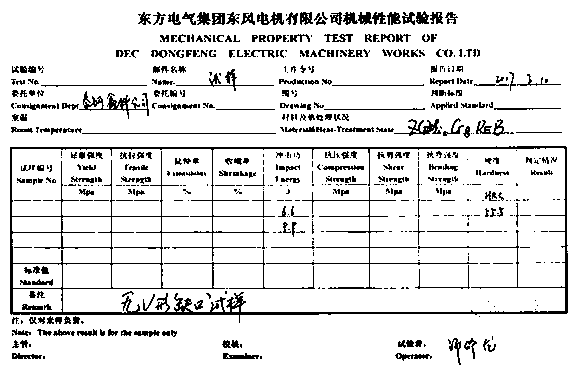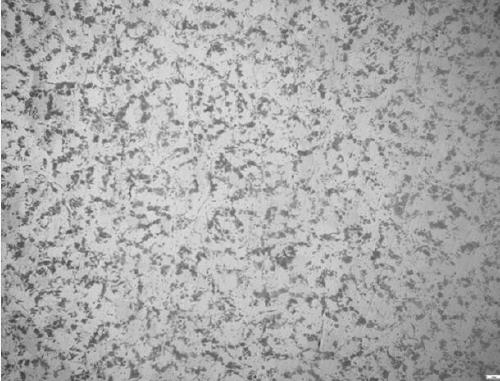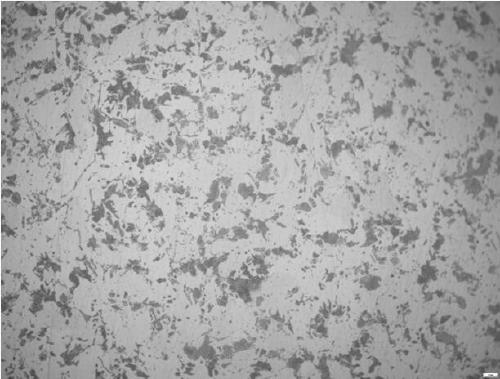Low carbon, low boron, and high chromium alloy steel and preparation method thereof
An alloy steel, carbon and low boron technology, applied in the field of alloy steel, can solve the problems of difficult control, high process requirements, and difficult civilian promotion, and achieve the effects of easy process control, good uniformity and low smelting cost
- Summary
- Abstract
- Description
- Claims
- Application Information
AI Technical Summary
Problems solved by technology
Method used
Image
Examples
Embodiment 1
[0063] As a preferred embodiment of the present invention, with reference to the accompanying drawings, this embodiment discloses:
[0064] Low-carbon, low-boron, high-chromium alloy steel consists of the following raw materials in weight percentage:
[0065] Carbon 0.05%;
[0066] Silicon 1%;
[0067] Manganese 0.8%;
[0068] Phosphorus 0.01%
[0069] Sulfur 0.02%;
[0070] Chromium 8%;
[0071] Nickel 0.5%;
[0072] Molybdenum 0.1%;
[0073] Boron 0.03%;
[0074] Aluminum 0.1%;
[0075] Tin 0.05%;
[0076] Vanadium 0.3%;
[0077] Tungsten 0.1%;
[0078] Copper 0.05%;
[0079] Tantalum 0.005%;
[0080] Cobalt 0.05%;
[0081] Niobium 0.05%;
[0082] Ce 0.8%;
[0083] The rest is iron and unavoidable impurities.
Embodiment 2
[0085] As another preferred embodiment of the present invention, with reference to the accompanying drawings, this embodiment discloses:
[0086] The low-carbon, low-boron, high-chromium alloy steel is characterized in that it consists of the following raw materials by weight percentage:
[0087] Carbon 0.1%;
[0088] Silicon 2%;
[0089] Manganese 1%;
[0090] Phosphorus 0.02%
[0091] Sulfur 0.02%;
[0092] Chromium 10%;
[0093] Nickel 1%;
[0094] Molybdenum 0.3%;
[0095] Boron 0.15%;
[0096] Aluminum 0.2%;
[0097] Tin 0.12%;
[0098] Vanadium 0.5%;
[0099] Tungsten 0.5%;
[0100] Copper 0.15%;
[0101] Tantalum 0.01%;
[0102] Cobalt 0.1%;
[0103] Niobium 0.15%;
[0104] Ce 1%
[0105] Titanium 0.05%;
[0106] The rest is iron and unavoidable impurities.
Embodiment 3
[0108] As another preferred embodiment of the present invention, with reference to the accompanying drawings, this embodiment discloses:
[0109] The low-carbon, low-boron, high-chromium alloy steel is characterized in that it consists of the following raw materials by weight percentage:
[0110] Carbon 0.30%;
[0111] Silicon 3.0%;
[0112] Manganese 1.3%;
[0113] Phosphorus 0.03%
[0114] Sulfur 0.01%;
[0115] Chromium 13%;
[0116] Nickel 2.5%;
[0117] Molybdenum 0.8%;
[0118] Boron 0.25%;
[0119] Aluminum 0.3%;
[0120] Tin 0.2%;
[0121] Vanadium 1.0%;
[0122] Tungsten 1.5%;
[0123] Copper 0.3%;
[0124] Tantalum 0.015%;
[0125] Cobalt 0.15%;
[0126] Niobium 0.25%;
[0127] Cerium 2%
[0128] Titanium 0.08%;
[0129] The rest is iron and unavoidable impurities.
PUM
 Login to View More
Login to View More Abstract
Description
Claims
Application Information
 Login to View More
Login to View More - R&D
- Intellectual Property
- Life Sciences
- Materials
- Tech Scout
- Unparalleled Data Quality
- Higher Quality Content
- 60% Fewer Hallucinations
Browse by: Latest US Patents, China's latest patents, Technical Efficacy Thesaurus, Application Domain, Technology Topic, Popular Technical Reports.
© 2025 PatSnap. All rights reserved.Legal|Privacy policy|Modern Slavery Act Transparency Statement|Sitemap|About US| Contact US: help@patsnap.com



